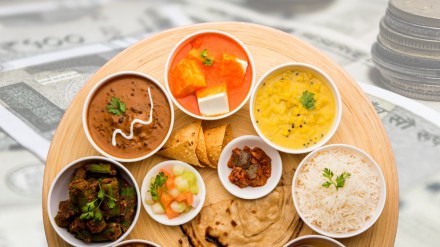While the cost of a home-cooked veg thali dropped by 14 per cent in comparison to the same period last year, the non-veg thali cost declined by around 13 per cent in July. This was largely due to a sharp drop in the prices of vegetables and also a dip in broiler prices, stated Crisil’s monthly Roti Rice Rate report.
For months before December, unlike the common perception, consumers have been paying more for the veg thali due to soaring vegetable prices. However, in December, the price of non-veg thali shot up twice as fast as the veg thali as the broiler prices had gone up by around 20 per cent YoY. Ever since, the veg thali cost has witnessed more decline as against the non-veg thali on easing inflation and subsequent drop in vegetable prices.
The average cost of preparing a thali at home is calculated based on input prices prevailing in north, south, east and west India. The monthly change reflects the impact on the common man’s expenditure. The data also reveals the ingredients (cereals, pulses, broilers, vegetables, spices, edible oil and cooking gas) driving the change in the cost of the thali.
A veg thali comprises roti, vegetables (onion, tomato and potato), rice, dal, curd and salad; and a non-veg thali has the same elements, except dal, which is replaced by chicken (broiler).
Bumper harvests cut veg thali cost, but oil and LPG curb drop
According to the CRISIL MI&A Research estimates, the cost of home-cooked vegetarian thali declined by 14 per cent on-year. The report attributed this to a sharp drop in the prices of vegetables—primarily tomato, onion and potato (TOP)—on a high base. During the month of July, tomato prices fell 36 per cent on-year to Rs 42 per kg in July from Rs 66 per kg, driven by a high base effect as the prices typically surge around July/August due to seasonality, even breaching Rs 100 per kg in 2023.
Further, prices of potato and onion declined 30 per cent and 36 per cent on-year respectively. During the same period last year, potato production dropped 5-7 per cent due to blight infestations and weather changes, which led to a rise in prices. For onion, an 18-20 per cent rise in annual production led to a dip in prices in 2025.
Prices of pulses declined 14 per cent on-year, driven by higher production and stock levels compared with the year-ago period and the cost of rice declined 4 per cent on-year.
However, according to the findings of the report, a rise in prices of vegetable oil and liquefied petroleum gas cylinder prevented the further decline in cost of veg thali. Despite the reduction in basic customs duty (BCD) on crude edible oils, vegetable oil prices surged 20 per cent on-year as the benefits of lower BCD have not yet been completely passed on to customers. Additionally, a 6 per cent on-year increase in liquefied petroleum gas cylinder prices added to the overall cost of thalis.
Pushan Sharma, Director, Crisil Intelligence, said, “In July, the cost of vegetarian and non-vegetarian thalis defied the typical seasonal uptick. Historically, tomato prices rose in June, peaking in the following two months due to lean supplies, as seen in 2023, when prices breached Rs 100 per kg in July and August.”
This time, however, despite a 31 per cent on-month increase, tomato prices averaged Rs 42 per kg in July, compared with Rs 66 per kg in the year-ago period when heavy rains disrupted supplies, he added.
Lower broiler prices ease non-veg thali costs
The cost for non-veg thali, Crisil said, dropped by around 13 per cent in July. Per the report, along with lower vegetable prices, an estimated 12 per cent on-year drop in broiler prices, drove down the cost of a non-veg thali. It is worth noting that broilers account for around 50 per cent of the non-veg thali cost.
Pushan Sharma added, “In the near term, thali prices are expected to remain lower on-year owing to a high base of tomato prices. Anticipated higher production of pulses is also likely to soften prices. However, the extent of the decline may be limited as potato and onion prices are expected to remain firm going forward.”
A MoM price update for veg and non-veg thali
Now, on a month-on-month basis, the cost of a veg thali increased by 4 per cent in July while that of non-veg thali declined by 2 per cent. During the month, tomato prices surged 31 per cent on-month, driven by a 27 per cent decline in arrivals, which, in turn, pushed up the cost of veg thali. Meanwhile, potato and onion prices edged up 2 per cent and 5 per cent on-month, respectively.
The cost of non-veg thali, however, declined by 2 per cent on an estimated 9 per cent on-month drop in broiler prices. “Broiler prices declined amid lower demand during monsoon and the onset of the Shravan month when a section of the population typically avoids consuming meat,” Crisil stated.
During the previous month, that is, June 2025, the cost of home-cooked vegetarian and non-vegetarian thalis declined by around 8 per cent and around 6 per cent on-year, respectively.
